Local Bifurcation and Global Stability of Two-Prey-One-Predator Model
Abstract
This paper deals with dynamical analysis of an ecological model. This model includes two logistically growing prey species, namely, Prey X and Prey Y, and the third species Z behaves as the predator, predating both Prey X and Prey Y according to the extended Holling type-II functional response. Furthermore, the effect of fear is incorporated in the growth rate of both species Prey X and Prey Y due to the predator Z. All the biologically possible steady state points are explored, and their local stability as well as global stability is analyzed based on the sample parameters. Next, we investigate the occurrence of local bifurcations around each steady state points by taking the value of the birth rate, death rate, and fear parameter as a bifurcation parameter. Finally, we perform extensive numerical simulations to support the evidence of our analytical results.
1. Introduction
1.1. Motivation and Literature Survey
To understand the dynamics of interaction between prey species and predator species, thousands of prey–predator models have been considered by mathematician authors [1–5]. The important element to represent the dynamics relationship between predator population and prey population is the functional response for the predator, which is defined as the number of consumed prey per predator per unit time [6]. The most useful functional response is the Holling type-II functional response, which is characterized by the decelerating intake rate [7]. Many authors used this type of functional response for modeling the dynamics of interactions between predator and prey [8]. In nature, lions are a real-world example of predator species that consume more than one species of prey, usually a number of large land-based animals, such as antelopes, buffaloes, crocodiles, giraffes, pigs, zebra, wild dogs, and wildebeest. There are some works modeling one predator and multiple preys [6, 7].
Eletterby in [2] discussed the global stability and persistence of a two preys and one predator model. Population dynamics may be affected by many factor such as fear, harvesting, toxicity, stage structure, delay, harvesting, cannibalism, antipredator skills, refuge, infectious illness, and other population-affecting elements of the natural environment [9–12].
Physiological changes of prey population may be caused by predation fears, and these physiological changes may reduce the reproduction of prey population. Zanette et al. [13] showed that the bird reduce 40 percent less offspring by the fear from predator. Wang et al. [14] considered a predator–prey model incorporating fear effect on reproduction of prey individuals; in their study, they noticed that the fear has no impact on the stability of the model when the system incorporate bilinear functional response, but the system becomes stable under fear effect, if it incorporate the Holling type-II functional response, based on their system. Pal et al. [15] considered a prey predator with fear effect and harvesting cooperation; they discussed the stability, Hopf bifurcation, and Bogdanov–Takens bifurcation of the system. Zhang et al. [16] considered an ecological model with fear effect and prey refuge, and they showed that the effect of both factors can stabilize the system. For more results about fear effect, see [9, 17–21]. It is important to study the effect of fear on the dynamics relationship between one predator species and more than one prey species. The aim of the current work is to model the impact of effect of fear on the dynamics of interaction between one predator species and two prey species.
1.2. The Model Formulation
- i.
In the absence of predators, fear of predator, each of prey species X and Y grows logistically with intrinsic growth rates r1 and r2 and carrying capacities k1 and k2, respectively.
- ii.
Each of prey species X and Y is killed directly by predator’s species according to functional responses (α1XZ/1 + α1T1X + α2T2Y) and (α2XZ/1 + α1T1X + α2T2Y), respectively. This type of functional responses is derived by the authors in [6] and they are the extension Holling type II for two preys, where α1 and α2 are the predator’s search efficiency for prey X and prey Y, respectively, and T1 and T2 are the predator’s average handling time of prey X and prey Y, respectively.
- iii.
The reproduction of each of prey species X and Y affected equally by indirect killing (fear effect) and it decreases by multiplying the intrinsic growth and them by (1/1 + fZ), where f is the level of fear due to both prey response to antipredators.
- iv.
The predator decreases due to natural death rate with rate d and intraspecific competition with rate c.
- v.
The biomass of prey X and prey Y conversed to biomass of predator with the conversion efficiency e1 < 1 and e1 < 1, respectively.
- 1.
Neglecting intraspecific competition among predators.
- 2.
The reproduction of each of prey species X and Y decreases by multiplying the birth rate and (1/1 + fZ).
1.3. Problem Statement and Key Contribution
- •
Examine the steady state point of System (2).
- •
Determine the important property of model’s solutions
- •
Investigation of local as well as global behavior at model’s equilibrium.
- •
Analysis of local bifurcation at equilibria.
- •
Numerical verification of theoretical results.
1.4. Layout of the Paper
The paper is organized as follows. In the next section, some properties of the model solution are investigated. In the Section 3, the existence conditions of all feasible equilibrium points are found. In Sections 4 and 5, stability analysis (locally as well as globally) and local bifurcations of the model is studied. In Section 6, the model numerically solved to discover the impact of fear. Finally, in Section 7, a brief conclusion on the total work is given.
2. Positivity and Boundedness
In this section, we will prove that the solution of System (2) is unique and bounded.
Theorem 1. If X(0) > 0, Y(0) > 0, Z(0) > 0, then System (2) exhibits a unique solution that is nonnegative.
Proof 1. The functions F, G, and H are continuous and have partial derivatives on the space R3; this guarantees that System (2) satisfies the Lipschitzian condition and hence it has unique solution. Furthermore, for the given initial conditions in the theorem, suppose that the components of the solutions of System (2) is not always nonnegative and since the initial are positive, so there exists a time T > 0 such that one of the following is true:
- 1.
x(T) = 0 and (dx/dt)(T) < 0.
- 2.
y(T) = 0 and (dy/dt)(T) < 0.
- 3.
z(T) = 0 and (dz/dt)(T) < 0.
But
- i.
If X(T) = 0, then from the first equation of the system given in equation (2) at time T, we get
(3) -
Which contradicts (dX/dt)(T) < 0.
- ii.
If Y(T) = 0, then from the second equation of System (2), we get
(4) -
This contradicts (dY/dt)(T) < 0.
- iii.
If Z(T) = 0, then from the third equation of System (8), we get
(5) -
Which contradict (dZ/dt)(T) < 0.
Hence, components X, Y, and Z of solution points is always nonnegative and this completes the proof.
Theorem 2. System (2) is bounded.
Proof 2. The first and second equations in System 1 give that
Let m = min{d, d1, d2} and applying above inequalities in System (2), and using the fact that conversion efficiency from biomass of prey to biomass of predator must be less than one, we get
So, the solutions are bounded and this completes the proof.
3. Existence of Steady State Points
- 1.
Extinct steady state P0(0, 0, 0), which always exists.
- 2.
Predator-free steady state P1((b1 − d1/c1), (b2 − d2/c2), 0), which is exists if and only if the following conditions hold:
(8)(9) - 3.
Only prey X existence steady state P2((b1 − d1/c1), 0, 0), which exists if and only if condition (8) holds.
- 4.
Only prey Y existence steady state P3(0, (b2 − d2/c2), 0), which is exists if and only if Condition (9) holds.
- 5.
Prey Y-free steady state P4(X4, 0, Z4), where
(10) -
with K1 = (d1 + c1X4)f + (d/e1X4).
-
Therefore, P4 is exists if and only if the following conditions hold:
(11) - 6.
Prey X-free steady state P5(0, Y5, Z5), where
(12) -
With K2 = (d2 + c2Y5)f + (d/e2Y5).
-
Therefore, P5 is exists, if and only if the following conditions hold:
(13) - 7.
Coexistence steady state P6(X6, Y6, Z6) m, where X6, Y6, and Z6 are positive roots of the following system:
(14)
4. Local Stability and Local Bifurcation
Throughout this section, the local stability and local bifurcation of System (2) are studied. In order to study the local stability of System (2), the Jacobian matrix of System (2) is computed at each of the equilibrium points and then the eigenvalues are determined. Also, we applicant Sotomayor’s bifurcation theorem on System (2) to investigate the occurrence a specify type of local bifurcation (qualitative change in the dynamical behavior) near the equilibrium points under the effect of varying a specific parameter. The necessary condition for the bifurcation to occur is the nonhyperbolic property of the equilibrium point. Therefore, in order to satisfy the purpose of this section, different parameters are selected so that the Jacobian matrix at an equilibrium point has zero eigenvalue and then study the effect of varying such parameter on the dynamical behavior of System (2).
So, the eigenvalues of J(P0) are λ0X = b1 − d1, λ0Y = b2 − d2, and λ0Z = −d.
Theorem 3. When b1 passes through , System (2) experience a transcritical bifurcation at P0(0, 0, 0) if Condition (20) holds. Furthermore, no bifurcation of a saddle-node and pitchfork bifurcation will occur at P0.
Proof 3. The eigenvalue λ0X of J(P0) becomes zero when , and others are negative under Condition (20).
Let and be eigenvectors of J(P0) and JT(P0) corresponding to eigenvalue λ0X = 0, respectively. Then, direct calculation shows that and , where and are nonzero real numbers.
Now,
According to Sotomayor’s theorem, no bifurcation of a saddle-node will occur at P0, whereas the first condition for a transcritical bifurcation is fulfilled.
Straight computation gives the following equation:
Accordingly, by Sotomayor theorem, System (2) near P0 with experience the transcritical bifurcation but pitchfork bifurcation cannot occur. The proof is completed.
The Jacobian at P1((b1 − d1/c1), (b2 − d2/c2), 0) is determined as
So, the eigenvalues of J(P1) are λ1X = d1 − b1, λ1Y = d2 − b2, and
Theorem 4. When d passes through , System (2) experiences a Trans critical bifurcation at P1((b1 − d1/c1), (b2 − d2/c2), 0), if λ1Z < 0 and aHxz(P1) + bHyz(P1) ≠ 0, where a and b are given in the proof. Furthermore, no bifurcation of a saddle-node and pitchfork bifurcation will occur at P1.
Proof 4. The eigenvalue λ1Z of J(P1) becomes zero when d = d∗ and others are negative under existence criteria (8) and (9) and the condition λ1Z < 0.
Let and be eigenvectors of J(P1) and JT(P1) corresponding to eigenvalue λ1Z = 0, respectively. Then, direct calculation shows that and , where and are nonzero real numbers.
Straight computation gives the following equation:
Therefore, System (2) near P1 with d = d∗ experience the Trans critical bifurcation but no bifurcation of a saddle-node and pitchfork bifurcation will occur at P1. The proof is completed.
The Jacobian at P2((b1 − d1/c1), 0, 0) is determined as
So, the eigenvalues of J(P2) are λ2X = d1 − b1, λ2Y = b2 − d2, and
Theorem 5. When d passes through d∗∗ = (e1α1(b1 − d1)/c1 + α1T1(b1 − d1)), System (2) experiences a Trans critical bifurcation at P2((b1 − d1/c1), 0, 0) if λ2Z < 0, Hxz(P2) ≠ 0 and condition (20) holds. Furthermore, no bifurcation of a saddle-node and pitchfork bifurcation will occur at P1.
Proof 5. The eigenvalue λ2Z of J(P1) becomes zero when d = d∗∗ and others are negative under the given conditions.
Let and be eigenvectors of J(P2) and JT(P2) corresponding to eigenvalue λ2Z = 0, respectively. Then, direct calculation shows that and , where and are nonzero real numbers.
Straight computation gives the following:
Under condition Hxz(P2) ≠ 0, is not zero. Accordingly, by Sotomayor theorem, system (2) near P2 with d = d∗∗ experience the Trans critical bifurcation but no bifurcation of a saddle-node and pitchfork bifurcation will occur at P2. The proof is completed.
The Jacobian at P3(0, ((b2 − d2)/c2), 0) is determined as
So, the eigenvalues of J(P3) are λ3X = b1 − d1, λ3Y = d2 − b2, and
Theorem 6. When d passes through , System (2) experiences a transcritical bifurcation at P3(0, ((b2 − d2)/c2), 0) if the condition (19) holds λ3Z < 0 and Hyz(P3) ≠ 0. Furthermore, no bifurcation of a saddle-node and pitchfork bifurcation will occur at E1.
Proof 6. The eigenvalue λ3Z of J(P1) becomes zero when d = d∗∗ and others are negative under the given conditions.
Let and be eigenvectors of J(P2) and JT(P2) corresponding to eigenvalue λ3Z = 0, respectively. Then, and , where and are nonzero real numbers with
Using the condition Hyz(P3) ≠ 0, straight computation gives the following equation:
Hence, System (2) near P3 with d = d∗∗∗ experiences the transcritical bifurcation but pitchfork bifurcation cannot occur. The proof is completed.
The Jacobian at P4(X4, 0, Z4) is determined as
One of the eigenvalue of J(P3) is λ4Y = (b2/1 + fZ4) − d2 − (α2Z4/1 + α1T1X4) and the other eigenvalues λ4X and λ4X are roots of the equation
Therefore, if P4 exists, then it is LAS, if and only if
Theorem 7. Assume Conditions (37) and (38) hold, then System (2) has a Hopf bifurcation near P4 as the parameter value f passes through the value f = f1, where f1 satisfies the following equation in f.
Proof 7. According to J(P4), at f = f1, we have
So, there is neighborhood around f = f1 such that
Then,
Clearly, λ4Y is negative if and only if Conditions (37) and (38) hold. Therefore, System (2) has a Hopf bifurcation near P4 at = f1 . Hence, the proof is completed.
The Jacobian at P5(0, Y5, Z5) is determined as
One of the eigenvalue of J(P3) is λ5X = (b1/1 + fZ5) − d1 − (α1Z5/1 + α2T2Y5) and the other eigenvalues λ5Y and λ5Z are roots of the equation
Therefore, if P4 exists, then it is LAS, if and only if
Theorem 8. Assume that Conditions (46) and (47) hold, then System (2) has a Hopf bifurcation near P5 as the parameter f passes through the value f = f2, where f2 satisfies the following equation inf.
Proof 8. According to J(P4) at f = f2, we have
So, there is neighborhood around f = f2 such that
Then,
Clearly, λ5X is negative if and only if Conditions (46) and (47) hold. Therefore, System (2) has a Hopf bifurcation near P5 at f = f2. Hence, the proof is completed.
The Jacobian at P6(X6, Y6, Z6) is determined as
All three eigenvalues of J(P6) satisfy
Therefore, if P6 exists, then it is LAS if and only if all the following Routh–Hurwize criteria hold:
Theorem 9. Suppose that AB = C at f = f3 and R1 + R2 < 0, then System (2) exhibits a Hopf bifurcation near coexistence steady state point as the parameter f passes through the value f3.
Proof 9. Equation (54) has two complex conjugate eigenvalues if and only if AB = C.
Therefore, eigenvalues of the Jacobian matrix at P6(X6, Y6, Z6) and f = f3 satisfy
The roots of equation (58) are
However, there exists a neighborhood N(δ, f3) of f3 such that for all values of f in N(δ, f3), the roots of equation (54) can be written in general as
Thus, by substituting λ1 = a(f) + ib(f) in equation (54) and calculating the derivative with respect to f, we get
Thus, by solving the linear system (61) for the unknown (da(f)/df), we get
So, for f = f3, it is easy to verify that
Also, condition R1 + R2 < 0 guarantees that λ3 is negative for all values of f. The proof is completed.
5. Global Stability
Global stability (or globally asymptotically stable [GAS]) means that any trajectories finally tend to the attractor of the system, regardless of initial conditions. Therefore, most of the biological systems, especially prey predator system, are needed to be globally stable. Since P2 and P3 are not LAS, so they cannot be GAS. However, GAS for each P0, P1, P4, P5, and P6 of System 1 is established in Theorems 3, 4, 5, 6, and 7, respectively.
Theorem 10. If P0(0, 0, 0) is LAS, then it also become GAS.
Proof 10. Let L0(X, Y, Z) = X + Y + Z.
Since P0 is LAS, so Conditions (8) and (9) are satisfied. Hence,
Thus, for any initial point limt⟶∞ L0 = 0 and hence limt⟶∞(X, Y, Z) = (0, 0, 0)
This completes the proof.
Theorem 11. Suppose that P1((b1 − d1/c1), (b2 − d2/c2), 0) exists, then P1 is GAS provided the following condition:
Proof 11. Consider the function
Clearly, L1(X, Y, Z) > 0 for (X, Y, Z) ≠ ((b1 − d1/c1), (b2 − d2/c2), 0) and L1((b1 − d1/c1), (b2 − d2/c2), 0) = 0.
Furthermore,
Applying the given condition, then it gets that
Hence, L1 is a Lyapunov function with respect to P1((b1 − d1/c1), (b2 − d2/c2), 0); this completes the proof.
Theorem 12. Suppose that P2(((b1 − d1)/c1), 0, 0) is LAS, then P2 is GAS provided the following condition:
Proof 12. Consider the function
Clearly, L2(X, Y, Z) > 0 for (X, Y, Z) ≠ (((b1 − d1)/c1), 0, 0) and L2(((b1 − d1)/c1), 0, 0) = 0. Furthermore,
Since P2((b1 − d1/c1), 0, 0) is LAS, then Condition (9) is satisfied. Therefore, under Condition (75), we observed that
Hence, L2 is a Lyapunov function with respect to P2((b1 − d1/c1), 0, 0); this completes the proof.
Theorem 13. Suppose that P3(0, (b2 − d2/c2), 0) exists, then P3 is GAS provided the following condition:
Proof 13. Consider the function
Clearly, L3(X, Y, Z) > 0 for (X, Y, Z) ≠ (0, (b2 − d2/c2), 0) and L3(0, (b2 − d2/c2), 0) = 0. Furthermore,
Since P3(0, (b2 − d2/c2), 0) is LAS, then Condition (8) is satisfied. Therefore, under Condition (72), we observed that
Hence, L3 is a Lyapunov function with respect to P3(0, (b2 − d2/c2), 0); this completes the proof.
Theorem 14. Suppose that P4(X4, 0, Z4) exists, then P4 is GAS if the following conditions are provided:
Proof 14. Consider the functions
Clearly, L4(X, Y, Z) > 0 for (X, Y, Z) ≠ (X4, 0, Z4) and L4(X4, 0, Z4) = 0.
Furthermore,
Choose
Clearly, D4x is always positive and D4y is positive under Condition (79). Furthermore,
So, (dL4/dt) is negative due Conditions (80)–(82). Hence, L4 is a Lyapunov function with respect to P4(X4, 0, Z4); this completes the proof.
Theorem 15. Suppose that P5(0, Y5, Z5) exists, then it is GAS, if the following conditions are provided:
Proof 15. Consider the functions
Furthermore,
Choose
Clearly, D5x is always positive and D5y is positive under the Condition (88). Furthermore,
So, (dL5/dt) is negative due Conditions (89)–(91). Hence, L5 is a Lyapunov function with respect to P5; this completes the proof.
Theorem 16. Suppose that P6(X6, Y6, Z6) exists, then P6 is GAS if the following conditions are provided:
Proof 16. Consider the functions
Clearly, L6(X, Y, Z) > 0(X, Y, Z) ≠ (X6, Y6, Z6) and L6(X6, Y6, Z6) = 0.
Furthermore,
Choose
Condition (97) guarantees that D6x and D6y are positive. Furthermore,
So, (dL6/dt) is negative due to Conditions (98) and (99). Hence, L6 is a Lyapunov function with respect to P6(X6, Y6, Z6); this completes the proof.
6. Numerical Simulation
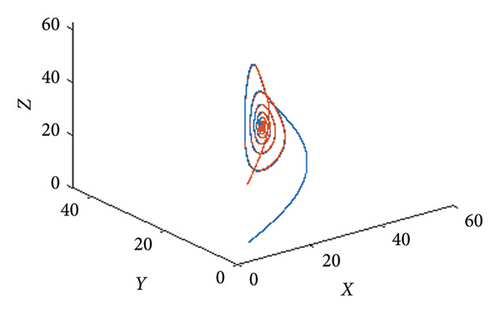
Let us increase the value b1 to 1.2 and fix other parameter values as given in equation (105), then parameter values satisfy the GAS conditions for Prey Y-free steady state point, and Figure 2 confirms that.
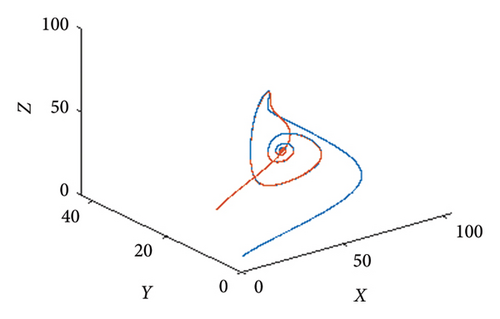
Again, let us increase the value b2 to 1.1 and fix other parameter values as given in equation (105), then parameter values satisfy the GAS conditions for Prey X-free steady state point, and Figure 3 confirms that.
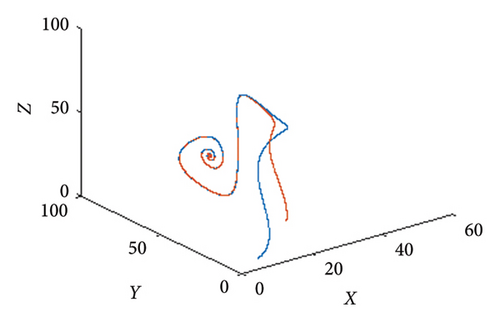
According to the fear level, it is observed the long-term behavior for a range of values f ∈ , in Figures 4, 5, and 6, and bifurcation diagram with respect to f is drawn. From Figure 4, all species show oscillatory for the small values of f. From Figure 5, the population of Prey X and predators show oscillatory for the further smaller values of f. From Figure 5, the population of Prey Y and predators show oscillatory for the further smaller values of f.
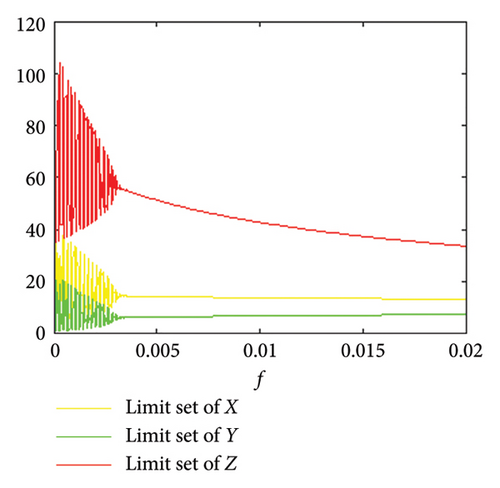
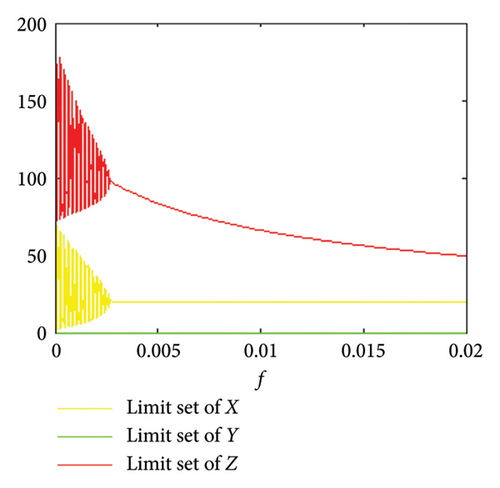

In general, Figures 4, 5, and 6 indicate that decreasing the fear level may induce a transition from the stability situation to the state where the populations oscillate periodically.
Let us increase the value of d to 0.3 and fix other parameter values given in equation (105), then λ1Z become negative, which satisfy the stable condition for the predator free steady state point, and Figure 7 confirms that.
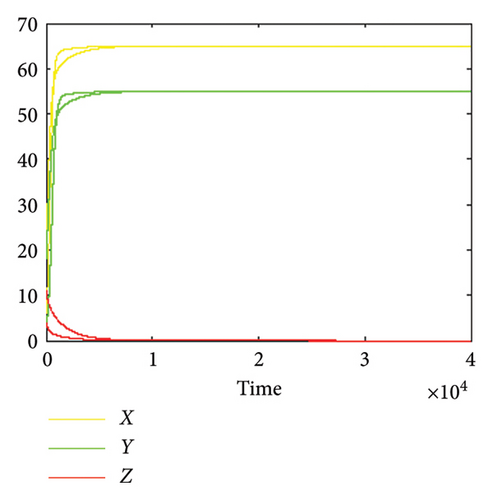
Let us solve System 1, when f ∈ [0, 10], d = 0.3, and other parameter values are fixed as given in equation (105), then the dynamics of system near predator free steady state point does not change; this confirms the theoretical result that the fear level has no impact on LAS of predator free equilibrium point; see Figure 8.
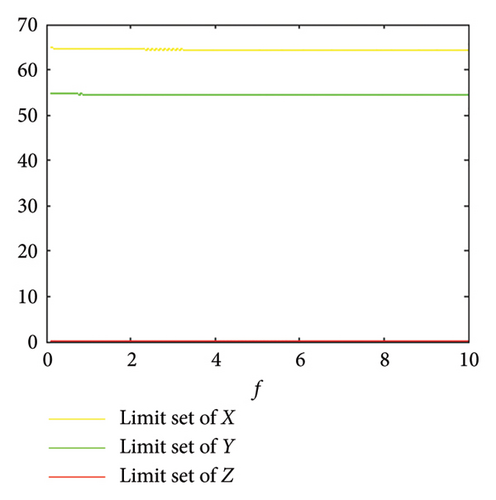
The above figure indicates that the fear level has no impact on the dynamics near predator free steady state point.
7. Conclusion and Discussion
In this paper, System 1 has been formulated, consisting of two prey species and one predator species, and it is taken to consideration the fear effect on both prey species. It is explored that System (1) has at most seven steady state points, and they are denoted by Pi, i = 0, 1, 2, 3, 4, 5, 6, in the criteria for local as well as global stability for each steady state. Local bifurcation such as trans critical, saddle-node, and pitchfork bifurcation near the steady states Pi, i = 0, 1, 2, 3, are studied. Also, bifurcating values of fear level of predators f for the occurrence of Hopf bifurcation in System (1) near prey X free, prey Y free, and coexistence steady state points are determined. Numerically, we have shown that if the value of fear level is decreased, then System (2) may induce a transition from the stability situation to the state where the populations oscillate periodically.
Conflicts of Interest
The authors declare no conflicts of interest.
Funding
We confirm that the Manuscript 9391001 received no external funding.
Open Research
Data Availability Statement
The data that support the findings of this study are available on request from the corresponding author.




